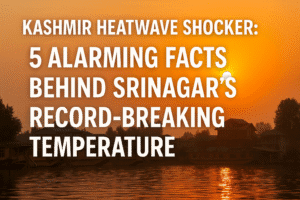Kashmir Heatwave Shocker: 5 Alarming Facts Behind Srinagar’s Record-Breaking Temperature
Srinagar, Jammu and Kashmir’s summer capital, recorded a historic 34.4°C on May 23—its hottest May day in 57 years and the third-highest since 1891, as confirmed by the IMD. The unprecedented heatwave, fueled by persistent dry spells and absent western disturbances, pushed temperatures 9°C above seasonal norms, disrupting life in the traditionally temperate valley. Nearby towns like Qazigund (33.5°C) and Kokernag (33.3°C) also broke local records, signaling a regional climate crisis.
While Kashmir baked, North India faced thunderstorms that diverted flights and stranded travelers, while coastal states like Maharashtra and Kerala braced for torrential rains and floods. Experts link these extremes to climate shifts, noting rising temperatures threaten Kashmir’s agriculture, water security, and public health, with glacial melt and erratic rainfall compounding risks. The anomaly underscores a broader trend: once-rare heatwaves and unseasonal storms are becoming frequent, urging urgent adaptation strategies. As Srinagar’s residents grapple with unfamiliar heat and farmers fear crop losses, the event serves as a stark reminder of climate change’s unequal toll, demanding policy action and community resilience to safeguard vulnerable regions.

Kashmir Heatwave Shocker: 5 Alarming Facts Behind Srinagar’s Record-Breaking Temperature
Srinagar, the summer capital of Jammu and Kashmir, shattered a 57-year temperature record this week as thermometers soared to 34.4°C on May 23—marking the hottest May day since 1968. The unprecedented heat, nearly 9°C above seasonal norms, underscores a worrying pattern of climatic extremes reshaping life in the Himalayan region.
A Record Broken, A Trend Revealed
The India Meteorological Department (IMD) confirmed the milestone, noting this as the third-highest May temperature since record-keeping began 133 years ago. Only 1968 (36.4°C) and 1956 (35°C) saw hotter days. Notably, the record toppled another recent high: just two days prior, Srinagar hit 34.3°C, edging out a 1971 benchmark.
The heatwave engulfed the entire Kashmir Valley:
- Qazigund, a southern town, recorded 33.5°C—its third-highest May temperature since 1956.
- Kokernag in Anantnag district shattered its 2001 record with 33.3°C, the highest since monitoring began there in 1978.
Why Is Kashmir Burning?
IMD experts attribute the surge to a prolonged dry spell, cloudless skies, and the absence of western disturbances—storm systems that typically bring cooling rains from the Mediterranean. These disturbances are vital for moderating spring temperatures and replenishing glaciers, which are now melting faster, compounding water scarcity fears.
Contrasts Across India: Storms, Floods, and Heat
While Kashmir sweltered, North India grappled with thunderstorms that diverted 12 Delhi-bound flights to Jaipur, stranding passengers for hours. Meanwhile, coastal and southern states faced deluges:
- Mumbai issued an orange alert (May 23–24) for heavy rains linked to a low-pressure system in the Arabian Sea.
- Kerala activated orange alerts in multiple districts through May 26, with torrential rains triggering landslides.
- West Bengal and Telangana braced for extreme rainfall and winds, highlighting India’s erratic weather mosaic.
Climate Shift or Anomaly?
The Srinagar heatwave isn’t isolated. IMD scientists warn such extremes align with global patterns of rising temperatures and disrupted weather systems. Urbanization and deforestation exacerbate heat island effects, trapping warmth in cities. For Kashmir, known for its temperate summers, the implications are profound:
- Agriculture: Apple orchards, saffron fields, and rice paddies—cornerstones of Kashmir’s economy—face drought risks.
- Health: Vulnerable populations, including the elderly, contend with heat stress amid limited healthcare infrastructure.
- Water Security: Glacial melt and reduced snowfall threaten the Indus River basin, a lifeline for millions.
Voices From the Ground
Local residents report unprecedented discomfort. “Fans and coolers are useless here; we’ve never needed them before May,” said Srinagar shopkeeper Aarif Bhat. Farmers like Ghulam Nabi voice anxiety: “If rains don’t come soon, our crops will fail.”
The Road Ahead
While IMD forecasts predict scattered showers and a slight temperature dip in Kashmir next week, long-term solutions demand urgency. Experts urge:
- Climate-Resilient Farming: Promoting drought-resistant crops and efficient irrigation.
- Urban Planning: Expanding green spaces and heat-reflective infrastructure.
- Policy Action: Integrating regional climate risks into national disaster management plans.
Conclusion
Srinagar’s record heatwave is a microcosm of a planet in flux. As temperatures climb and weather grows unpredictable, the crisis underscores a universal truth: climate change spares no one, from Kashmir’s valleys to Mumbai’s streets. Adapting to this new normal isn’t just optional—it’s a race against time.
You must be logged in to post a comment.